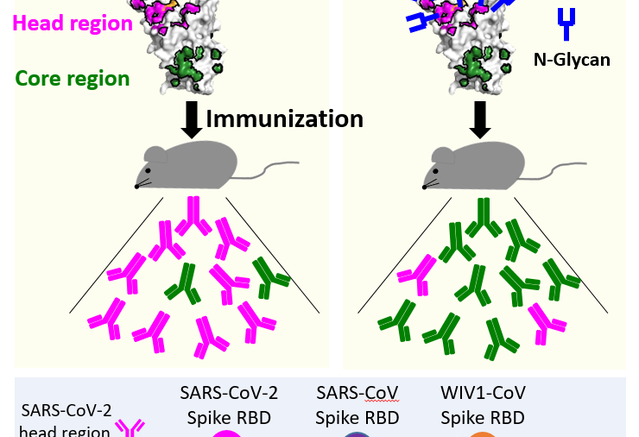To induce antibodies predominantly targeting regions in the RBD that are structurally conserved among SARS-related viruses, glycan engineering was performed to mask the non-conserved, dominant epitope on the RBD head region. When mice were immunized with this modified RBD vaccine, antibodies that recognize the core-RBD region of not only SARS-CoV-2 but also other SARS-related viruses, such as SARS-CoV or WIV1-CoV, were predominantly induced. These induced antibodies are highly protective against various SARS-related viruses. Courtesy of Ryo Shinnakasu, et al.
The coronavirus disease 2019 (COVID-19) pandemic, caused by the β-coronavirus severe acute respiratory syndrome coronavirus 2 (SARS-CoV-2), alerted the world to the seriousness of the threat posed by novel viruses. To protect the world’s population from similar future outbreaks, broadly protective vaccines against SARS-related coronaviruses are urgently needed. In a recent study published in Journal of Experimental Medicine, a team of researchers led by Osaka University generated an immune antigen that was based on a conserved protein on the surface of SARS-related viruses. When used to immunize mice, this antigen elicited cross-neutralizing antibodies against SARS-related viruses.
The coronavirus spike protein is a protein on the surface of SARS-CoV-2 that plays a vital role in attaching to, and entering, host cells. Specifically, it is the receptor-binding domain (RBD) of spike protein that enables the virus to attach to host cells and is therefore a target for the development of neutralizing antibodies, and a promising vaccine candidate. The RBD is made of two regions: the head and the core. The head is more immune-reactive and thus is the region against which most antibodies are naturally created. However, the head is more prone to variation, and it is the core region that is structurally conserved amongst SARS-related viruses. Therefore, it is crucial that antibodies are raised against this conserved core region of the RBD to generate cross-protection against multiple SARS-related viruses.
As lead authors Ryo Shinnakasu and Shuhei Sakakibara explain, “The key to generating a vaccine that offers broad cross-protection among related viruses is to target a structure on the viral surface that is highly conserved. Our approach was to generate a vaccine in which the non-conserved region was masked from the immune system by the introduction of a carbohydrate molecule (or glycan) by a method known as glycan engineering. This would in turn expose the conserved core region of the RBD of spike protein.”
When used to immunize mice, protective antibodies were induced that recognized the RBD core region not only of SARS-CoV-2 but also of other SARS-related viruses, such as bat SARS-like coronavirus, WIV1-CoV.
This finding is particularly promising because it demonstrates the potential for highly protective vaccines against various SARS-related viruses.
As senior author Tomohiro Kurosaki warns, “Despite the existence of effective vaccines against current viruses, there is potential for the emergence of similar viruses in the future. This highlights the real need for broadly protective vaccines against SARS-related coronaviruses.”
The novel approach of vaccine design that they describe may help protect against a future global health crisis such as that experienced during the COVID-19 pandemic.
The article, “Glycan engineering of the SARS-CoV-2 receptor-binding domain elicits cross-neutralizing antibodies for SARS-related viruses,” was published in Journal of Experimental Medicine at DOI: https://doi.org/10.1084/jem.20211003
Source: Osaka University
